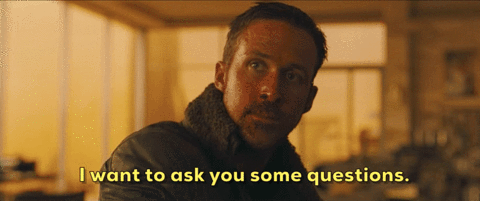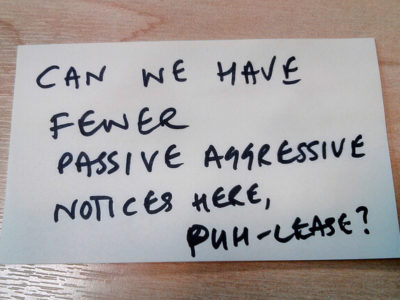You walk into your Friday morning class and sit down next to one of your buddies. She comments, “I saw you went out from your Snapchat last night. I’m not mad you ditched me for a party.” Um, what just happened? Is your friend actually mad or not?
What do these vague and almost rude conversations really mean? Passive aggressive behavior gets frustrating because we never really know how to respond. A lot of the time this behavior makes us angry or confused and cause us to confront the person—but confrontation only works well in a perfect world. “Some cultures are less accepting of direct aggression (e.g., hitting, yelling) than others. In the U.S., it seems that cultural acceptance of direct aggression has gone down over the last 200 years (think duels in the 1800s versus now),” said American University Psychology Professor Nathaniel Herr, Ph.D.
Society teaches us not to act like the cast of the Jersey Shore in public, so many people act in a passive aggressive way to avoid showing how they actually feel. “Often passive aggression is enacted in a way that makes it ambiguous if the person is really trying to be aggressive or not. Thus, the likelihood that the target of the aggression will retaliate is lower. So, choosing passive aggression is safer,” said Herr. People always say not to cry over spilt milk… maybe the same goes for a passive conversation. Ending a friendship because of poor communication is never worth it.
How to deal with passive aggressive people
1. Just go with it—don’t retaliate

First, remember not to engage with their passive aggressive talk. People love to stir the pot and cause drama— don’t be a part of it. “There’s another type of aggression often called indirect aggression that is similar to passive aggression. This involved gossiping, backbiting, social exclusion or doing other things that hurt others,” said Dr. Herr. Yeah, don’t try to hurt them back with that. Ignore their advances and move on with your life. You don’t have to give in to their behavior.
2. Be true with your feelings

As corny as it sounds, be true with yourself and your feelings. Speaking firmly and directly goes a long way. A backhanded compliment like, “You look so much better in that dress this year than last,” gives you every right to explain why you feel upset. You have the power here to break the cycle of passive aggressive comments— do everyone in your social circle a favor and stand up to the bully. “Respond to aggression with words that suggest that what the other person is feeling makes sense given the situation. We recently published research showing that responding with a type of validation called normalizing (‘it makes sense that you are feeling so sad’) reduced aggression among people who are more prone to being aggressive,” said Dr. Herr.
3. Be aggressive, but nice

Act like they tell you to on the middle school basketball court: Be aggressive. But add some sweetness to it. Fighting back to passive aggressive friends may be the only way they learn. A huge part of passive aggressive behavior is avoiding the situation at hand which makes it your job to be direct. “Aggression from one person tends to pull for aggression in another. So, an aggressive response to aggression tends to escalate the situation. Alternatively, friendliness tends to pull friendliness,” said Dr. Herr. If someone types in your house group chat that they always clean up after everyone, but of course, they are fine with it, ask them to have an upfront discussion about their feelings. News flash: They probably aren’t actually fine. “‘Rolling with the punches’ as they say—letting the aggression bounce off you or move right past you—and responding in a friendly manner often, over time, reduces the urge for the other person to continue being aggressive,” said Dr. Herr.
4. Understand the person you’re dealing with

Some people learn from tough love while others don’t. Make sure when asserting yourself with someone, you understand where they are coming from and how to change their passive aggressiveness. “I’d recommend keeping in mind that usually people are aggressive when they think that you are in the way of something they want. At minimum, that helps you remember that they see you as in a better position in some way and their goal is to be in a better position themselves,” said Dr. Herr.
If you’re dealing with a more shy, passive aggressive friend, talk to them privately about their behavior and how it affects you. Ask them why they are feeling this way and try to get them to understand your point of view. If your friend gets defensive, ensure them they are not wrong and that their feelings are valuable.
5. Stay on topic when confronting and stick to empathy

Focus plays an important role in everything, but especially when confronting someone. In other words, don’t lecture them on how they take 40-minute showers. Stay focused and get to the point so that they have your full attention. Make sure you deliver your concerns about their remarks in a way that doesn’t make them feel victimized. “Most people can empathize by remembering a time when they themselves felt that someone else was standing in the way of something they wanted,” said Dr. Herr. “Remembering how bad that felt (for you) and how difficult it can be to learn that you may never get what you want may help one to have empathy for someone else who feels that way and then uses passive aggression.”
How to stop being passive aggressive
1. Say what you mean from the start and own your feelings

Express your feelings from the start…you are entitled to them. Stopping your passive aggressive tendencies won’t come easily, but Dr. Herr has some suggestions. “Increase our mindfulness and our self awareness about our emotional state.” Your roommates and friends will feel so much happier if you directly tell your feelings. If you unapologetically tell your friend that they need to cool it with the shots because you don’t want to take care of them that night, they will respect you more for saying something assertive and true than something passive.
“Be more accepting of our negative emotions such as sadness, anxiety and guilt/shame,” said Dr. Herr. “A lot of times anger is what we call a ‘secondary emotion.’ It is better to show people that you are angry than that you are sad or embarrassed, so when someone feels sad, they quickly get angry about being sad and show just the anger.” Sound familiar? Who hasn’t lashed out when they felt attacked? “If we accept that it’s okay to be sad or to be anxious, then we stop being angry about being sad or anxious and that means we’re less likely to be aggressive or passive aggressive,” said Dr. Herr.
2. Identify the situations when you are most likely to be passive aggressive

What situations egg on your passive aggressive side? Which person in your life brings it out the most? Once you know when exactly this behavior comes about, you’ll know when you have to change it. “I can always feel when I’m starting to get passive aggressive. It’ll start with a petty comment and before I know it I’m acting like a catty pre-teen. I’ll always try to stop myself, but I can feel the passive aggressive behavior creep up,” said American University senior Jessica Philips. Small changes can help in the slightest ways. Start by trying to be more assertive and less passive with your close friends and family— people who love you no matter what. Once you begin practicing less passive aggressive tendencies, you will begin to act that way in everyday conversation and when you have to deal with those sticky situations.
3. Listen to and observe others

Sometimes it’s a good idea to listen in on other conversations to see how they play out in the end. In fact, it helps you identify when someone else acts passive aggressively and can give you an example of what not to do. By recognizing the way someone else becomes passive aggressive, it may help you understand how to change your own behavior. Listen to conversations and think of ways to avoid a passive aggressive situation.
4. Lose the sarcasm

Sorry, but killing the sarcasm becomes a must if you’re a repeat offender of passive aggressive comments. Sarcasm can be witty and even necessary in some convos, but if you’re trying to change your passive aggressive ways you have to lose this attitude. Many do not understand sarcasm and may make them feel ostracized or uncomfortable. Stick with a happy go lucky attitude instead.
5. Ask questions

If you feel super uncomfy being direct and assertive, combating aggressiveness and passiveness can be a piece of cake. You’ll find ways to show neither aggression or passive behavior in a situation. You can ask direct questions get the point across without feeling aggressive.“It’s important to be direct because other people can’t always read your mind,” said AU senior Natalie Hedden. If you see someone taking up a four person table in the library during finals week, ask with genuine curiosity if they’re waiting for more people to join them. Most likely they’re solely occupying it and now you get a killer study seat in the lib. In this situation you’ll notice a lack of passive aggressive behavior. Instead, a direct question got the job done. “If you don’t say exactly how you feel or exactly what you want, people may never know,” said Hedden. In this situation, everyone got their way without being passive aggressive. Win win all around, am I right?



















